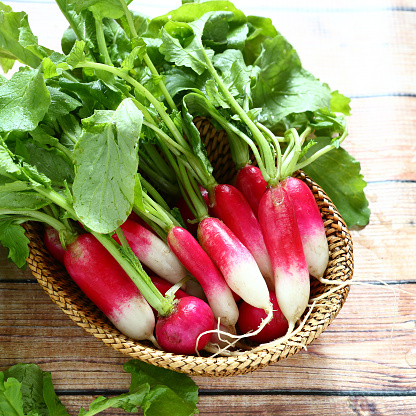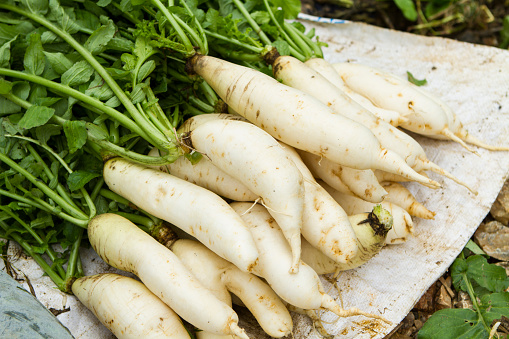The radish with its crispiness and the peppery taste makes perfect finger food and add a tasty crunch. Raw radishes are great in salads. Also, they make tasty pickles and even are tasty in a stir-fry or soup. Juicy radishes can be long or round and colorfully red, black, white, purple, or black. And they are a superfood packed with health benefits.
Now let’s learn how they help detox the liver, inhibit cancer, are good for helping diabetes, and much more.
8 Radish Health Benefits
1. Great for Detoxifying the Liver
The liver’s job is to help cleanse toxins out of the body; in this process, toxins can accumulate in the liver so it needs a little help. Spanish Black Radish was found in a study, to help with detoxification of acetaminophen (Paracetamol), a medication which can cause liver damage.
2. Low in Calories and High in Nutrients
A handful of radishes (6 – 8) has only 5 calories! They have about 70 mg of potassium and many vitamins, minerals, and even a little protein. Here is all the Radish Nutrient Data.
3. Reduces Kidney Stones
Calcium oxalate in the urine is the component that helps to create kidney stones. A diet with radishes increases the excretion of calcium oxalate according to research.
4. Beneficial for Weight Loss
Because they are low in calories and high in fiber radishes make great snacks.
5. Inhibits Cancer
In a study, radishes were found to inhibit cancer cell growth and prompted cancer cell death.
6. Can be helpful for Diabetes
Radish juice is better than glibenclamide, an antidiabetic drug according to research as it possesses a hypoglycemic potential.
7. Useful for a Skin Disease
The chronic skin disease, Vitiligo is a disease that causes the skin to lose colour leaving white patches on the body. Research found the paste of radish seeds to be helpful in treating vitiligo. Grind the seeds, mix with vinegar, and then apply on the white patches.
8. Can Decrease Blood Pressure
Radishes being high in potassium can help to reduce blood pressure.

Please Note
Radishes may contain goitrogens, which are found in Brassica and cruciferous vegetables. Goitrogens may cause thyroid dysfunction. There is no problem for those without a thyroid condition. Cooking makes goitrogenic substances inactive.
“Radishes grow just about anywhere.
People think, ‘Oh it’s just a radish.’ But radishes are delicious……”
~ Emeril Lagasse
Radish Trivia
- “Radish” means “root,” and comes from the Latin “radix.”
- Before olive oil was known, radish seed oil was used by ancient Egyptians instead.
- Did you know that 400 million pounds of radishes are consumed by Americans a year!
- Peter Rabbit was a radish eater and enjoyed a long variety called Long Scarlet which is in an illustration in the Beatrix Potter book.
- “The Night of the Radishes” on December 23rd in Oaxaca, Mexico, is a radish celebration featuring nativity scenes carved from radishes!
- Radishes are a root from the Brassica family (cabbage, broccoli, cauliflower, and turnip).
- They were served on golden platters to the gods in ancient Greece.
“As God is my witness, I’ll never be hungry again,” said Scarlett O’Hara after eating a radish in the novel Gone With The Wind.
History of Radishes
- Historians are not clear where they first came from. Some say radishes were first cultivated in ancient Egypt in 2700 B.C. Others say radishes were grown in China as early as 2,700 B.C.
- Herodotus (484 – 425/413 BC) claimed to have seen an inscription of radish on a pyramid but the Greeks said they introduced radishes to Egypt. – Academics Hamilton Edu Research
- The discrepancy about radishes may be due to the many varieties of radishes. The daikon was and still is a favourite in China and Japan and the round red bulb radish is a favourite in Europe and North America to this day.
- Radishes arrived into Europe in the 1500s and in Massachusetts by 1629.
Selecting the Best Radishes
They are best when they are small and firm because when they are too large, they become too peppery, hollow, and tough. If it is soft, it is likely to be pithy instead of crispy. It is best to avoid radishes that have cracks or cuts on their surface. When they still have leaves on then you will know that they are still fresh and crunchy. Make sure the leaves are green, not limp or yellow. Don’t throw the leaves away. Save the leaves as they can add a little heat to a salad or soup and some extra nutrients.

How to Best Store Radishes
When the leaves are still on the radishes they can only be stored in the refrigerator for 3 to 5 days, but once the leaves are removed they can last for 2 to 4 weeks when refrigerated.
Daikon and black radishes without leaves can be stored for months in the refrigerator.
Crisp, peppery little summer radishes are indeed the perfect way to kick–start a meal, bold enough to set the gastric juices flowing, yet barely denting the appetite. ~ Sophie Grigson, Author of The Vegetable Bible
Did you know you can use the Greens From the Radishes?
- Quickly steam them and dress them with olive oil and a squeeze of lemon juice.
- Sauté the greens with onions and add herbs such as mint, basil, thyme or dill.
- You can add them to your green smoothie.
Here are some delicious recipes with radishes:
I have always enjoyed radishes since child age. We grew them in the garden and I would pick one and wash it off outside and eat it just like that. Here are some recipe I created for more radish fun.

Tasty Radish Sandwich – who would have thought of making a sandwich with radishes that tastes so good.
Braised Radishes with Dill – yes you can cook radishes and this dish is very tasty.
Quick Tasty Radish Pickles – if you like pickles then you will enjoy these yummy ones.
Delicious Radish Quinoa Salad with Arugula – This colorful radish quinoa salad is a yummy and nourishing salad for any season. It is full of good protein from the quinoa. It is a whole meal in one bowl.
100+ Superfoods
Learn more about some of the healthiest vegetarian foods you will always want to have in your pantry or growing on your deck.
READ: Superfoods – Over 100 of the Healthiest Foods You Should Have in Your Diet and learn more about the variety of Superfoods we think you should have in your diet.


A correction might be in order for benefit #3. As your text says, kidney stones occur because of too much calcium oxalate in urine. Therefore increasing the amount of calcium oxalate through increased excretion actually makes kidney stones worse.